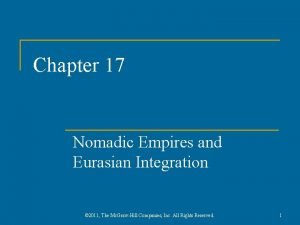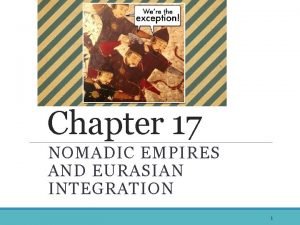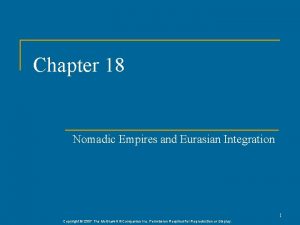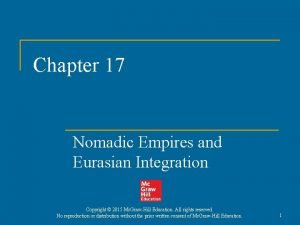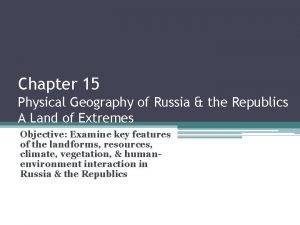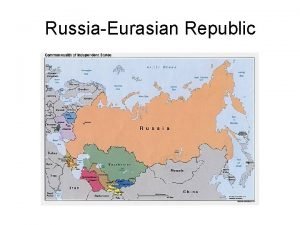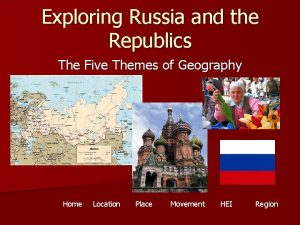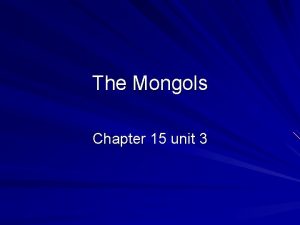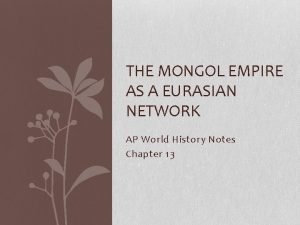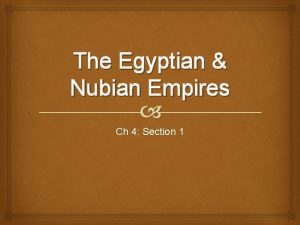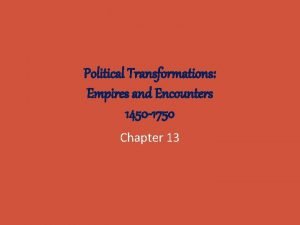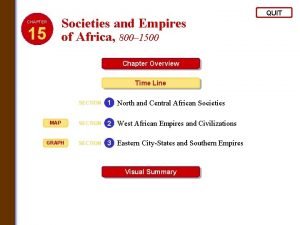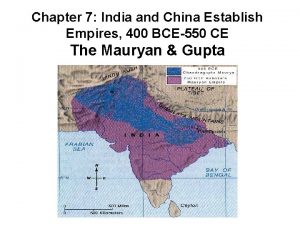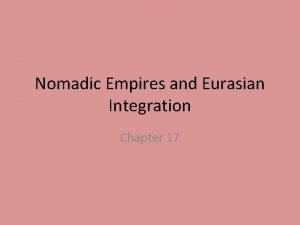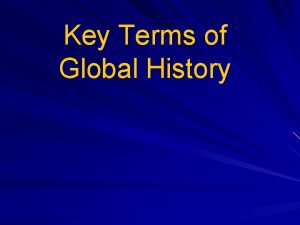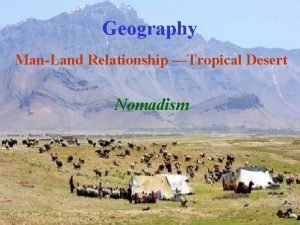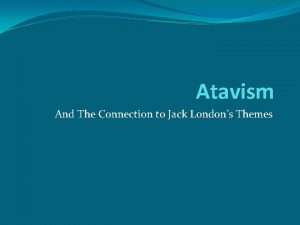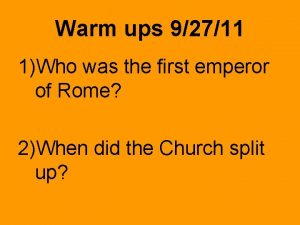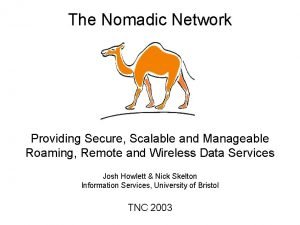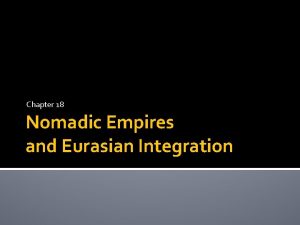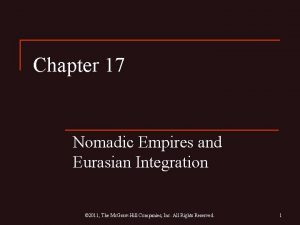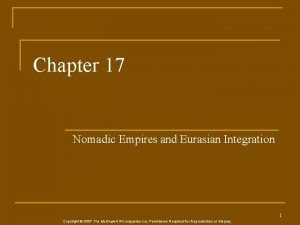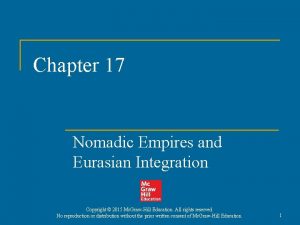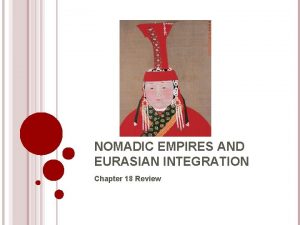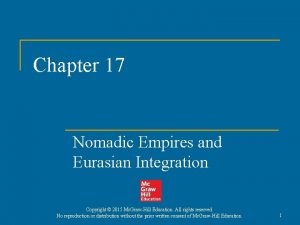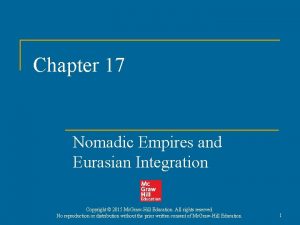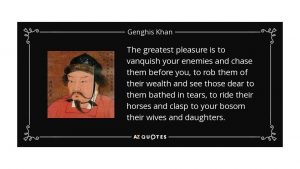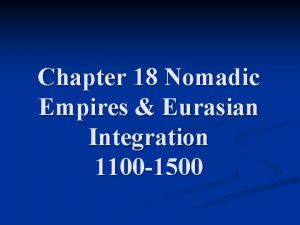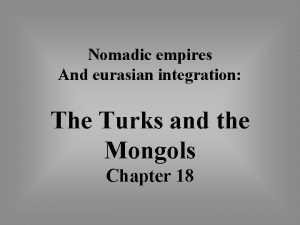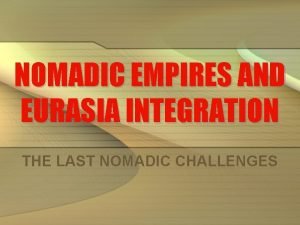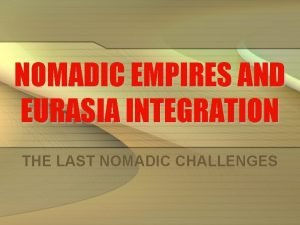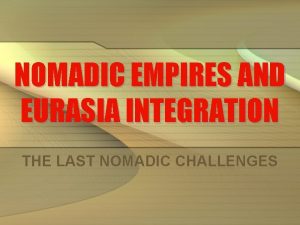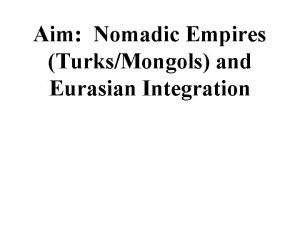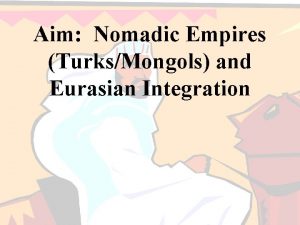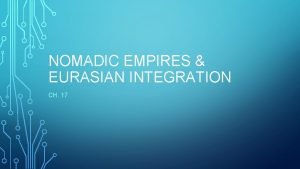Nomadic Empires and Eurasian Integration Chapter 17 I

























- Slides: 25

Nomadic Empires and Eurasian Integration Chapter 17

I: Turks - Economy and Society of Nomadic Pastoralism • Nomadic Pastoralists: keep and live off of herd animals, esp. in arid lands (e. g. , steppes) • Trade is important with settled peoples – Also, led camel caravans between China and the Med.

I: Turks - Nomadic Society • 2 social classes: nobles (semi-inherited, led and formed alliances, but didn’t really govern) and commoners (bravery in war -> nobles) • Patriarchal, but women had higher status than in agricultural societies – Tended herds (econ. function) -> status and influence

I: Turks - Nomadic Religion • Early: shamanistic • Later: many converted to religions of salvation: Buddhism, Nestorian Christianity, Manachaeism (also developed written script) • With rise of Islam, most converted – Late 10 th century: Seljuk clan converted, migrated to Persia, and formed alliances with Abbasids (puppet gov’t) – Between 10 th and 14 th centuries, most other Turkish clans converted to Islam

I: Turks - Military Organization • Expansion – confederation of people under a khan (not direct control, through leaders of allied tribes) – Strong cavalry (horse culture, archery) – Coordinated movements, mobility, discipline

I: Turkish Empires – Seljuk Turks and the Abbasid Empire • Lived along border of Abbasids for trade • Then, many served in army and lived in empire • By mid-11 th century: Seljuk Sultan more powerful than Abbasid caliphs, and expanded control to Syria, Palestine, etc.

I: Seljuk Turks & the Byzantine Empire • Early 11 th century: migrations into Anatolia • 1071: defeated Byzantines at Battle of Manzikert • Many peasants supported them – Set up political and social institutions , converted many to Islam

I: Ghaznavid Turks & the Sultan of Delhi • Mahmud had led raids from Afghanistan into India • 13 th century: successors took over N. India as the Delhi Sultanate – Army (with elephant corps) maintained borders but couldn’t spread into southern India – Destroyed Hindu and Buddhist temples, shrines and encouraged conversion to Islam

II: The Mongol Empires • From east and central Asian steppes • Social organization based on families, clans, tribes • Early 13 th century: Chinggis (Genghis) Khan mastered steppe diplomacy (bravery in battle, loyalty to allies – sometimes, ability to ally with unaffiliated tribes) • By 1206, united all Mongol tribes and became Chinggis Khan

II: Mongol Political Organization • Statecraft policies: – Broke up tribes & conscripted men into non-tribal units – Chose military and political leaders by talent – Successors established capital at Karakorum – Army => power (despite small population): horse culture, bows, mobile, psychological warfare

II: Mongol Conquest • N. China: beg. In 1211 by Chinggis Khan – By 1220: controlled N. China, capital at Khanbaliq • Persia: 1218, wanted trade/diplomatic relations -> Shah murdered merchants and envoy – Revenge – defeated shah’s army and destroyed everything (leveled cities, massacred people, destroyed qanat system, killed the caliph)

II: Mongol Conquest • 1227: Chinggis Khan died – Laid foundation for vast empire, but left no central gov’t for administration (ruled through overlords)

II: The Mongol Empires (after C. K) • Sons and grandsons struggled for power -> divided empire into 4 regional empires – China, Khanate of Changhata in C. Asia, Ilkhanate of Persia, Golden Horde in Russia • Constant tension between the khans of each

II: China and Kublai Khan • Consolidated Mongol rule in China: ruled 1264 -1294 – Military leader, also interested in cultural matters (improved welfare, promoted religions) – Attacked and conquered Southern Song – Established Yuan dynasty (1279 -1368) – Tried to expand unsuccessfully (SE Asia, Japan)

II: Mongol Rule in China • Did not adopt Chinese culture (saw them as “cultivators”) – No intermarriage, Chinese could not learn Mongolian – Brought in foreign administrators (Arabs, Persians, Europeans, Mongols) – Dismantled Confucian education and exam system • Religious tolerance: esp. supported Lamist Buddhism, despite keeping their shamanistic religion

II: The Golden Horde in Russia • Conquered between 1237 -1241 • Did not occupy (preferred steppe), but exacted tribute until mid-1400 s when Muscovy princes kicked them out

II: The Ilkhanate of Persia • Kublai’s brother, Hulegu conquered Abbasids • In 1258: took Baghdad and executed Caliph – Tried, but failed to expand throughout SW Asia and Egypt • Administration: Persians maintained order and collected taxes – Adopted Persian culture: converted to Islam and became part of Persian society

II: The Mongols & Eurasian Integration • Lots of destruction, but also increased interaction – -> encouraged communication (courier network with relay stations to transmit news, gov’t orders) – -> encouraged LD trade (safety through territories -> increase in volume and commercial investments) – -> sent out diplomatic missions (communication between khans and other rulers)

II: The Mongols & Eurasian Integration (cont. ) – -> missionaries (Sufis, Lamist Buddhists, Nestorian Christians, Roman Catholics) – -> resettlement: moved specialists (artisans, literate admin. , etc. ) from allies and conquered people to areas where they were needed

II: Decline of the Mongols in Persia • Collapse of the Ilkhanate: – Financial issues: excessive spending and overexploitation of the peasants; printed paper money to fix it -> failed and commerce stopped – Factional struggles: 1335 – no heir • -> local gov’ts formed

II: Decline of the Mongols in China • Decline of the Yuan Dynasty: – Economic: did not back up paper money -> lost value > prices soared – Factions and imperial assassinations, civil wars – Plus, 1330 s - spread of bubonic plague (facilitated by trade and communication) -> disrupted society -> depopulation and labor shortages – Also, 1340 s - rebellions and banditry ensued – 1368: rebels captured Khanbaliq and Mongols returned to the steppes

III: After the Mongols: Tamerlane • Turks restarted expansion • Tamerlane: filled power vacuum left in Persia – Charismatic leader -> attracted followers – 1360 s: eliminated rivals (defeat or alliance) – 1370: took over Khanate of Chaghatai (capital = Samarkand)

III: After the Mongols: Tamerlane – Led armies on campaigns of conquest: Persia, Golden Horde, India, SW Asia, Anatolia, and died on his way to China – Again, conqueror, not governor – no imperial administration (ruled through allied tribal leaders sand overlords who used existing bureaucratic structures, collected taxes and tribute) – Fell apart after his death (divided into 4 parts)

III: After the Mongols: Ottomans • Turks in Anatolia: campaigns of conquest by Osman • 1299: declared independence from Seljuk sultan; began fighting Byzantines (attracted followers) • Continued to gain power and expand until 1402 when they were defeated by Tamerlane

III: After the Mongols: Ottomans • By 1440 s: recovered and ready to expand into Byzantine Empire • 1453: Sultan Mehmed II sacked and captured Constantinople (-> Istanbul) • By 1480: expanded throughout SE Europe, SW Asia, N. Africa
 Chapter 17 nomadic empires and eurasian integration
Chapter 17 nomadic empires and eurasian integration Nomadic empires and eurasian integration
Nomadic empires and eurasian integration Chapter 18 nomadic empires and eurasian integration
Chapter 18 nomadic empires and eurasian integration Chapter 17 nomadic empires and eurasian integration
Chapter 17 nomadic empires and eurasian integration How are maritime and land based empires similar
How are maritime and land based empires similar Russia and the eurasian republics physical map
Russia and the eurasian republics physical map Russia and the eurasian republics
Russia and the eurasian republics Russia and the eurasian republics physical map
Russia and the eurasian republics physical map Chapter 15 the last great nomadic challenges
Chapter 15 the last great nomadic challenges The mongol empire as a eurasian network
The mongol empire as a eurasian network Advantages and disadvantages of nomadic farming
Advantages and disadvantages of nomadic farming Chapter 4 section 1 the egyptian and nubian empires
Chapter 4 section 1 the egyptian and nubian empires Chapter 5 political transformations empires and encounters
Chapter 5 political transformations empires and encounters Chapter 16 people and empires in the americas
Chapter 16 people and empires in the americas Chapter 15 societies and empires of africa
Chapter 15 societies and empires of africa Chapter 7 india and china establish empires
Chapter 7 india and china establish empires Forward integration and backward integration
Forward integration and backward integration Backwards intergration
Backwards intergration Example of simultaneous integration
Example of simultaneous integration Nomadic religion
Nomadic religion Dharma definition
Dharma definition Nomadic herding definition ap human geography
Nomadic herding definition ap human geography Old longings nomadic leap
Old longings nomadic leap Why do geographers call arabia a crossroads location
Why do geographers call arabia a crossroads location Nomadic network
Nomadic network Nomadic user disebut juga
Nomadic user disebut juga
